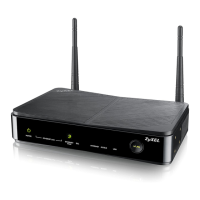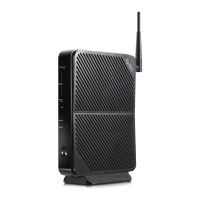Chapter 6 Broadband
SBG3500-N Series User’s Guide
110
WAN IPv6
Address
Enter the IPv6 address assigned by your ISP.
Prefix
Length
Enter the address prefix length to specify how many most significant bits in an IPv6 address
compose the network address.
Next Hop Enter the IP address of the next-hop gateway. The gateway is a router or switch on the
same segment as your SBG3500-N Series's interface(s). The gateway helps forward packets
to their destinations.
IPv6 Routing
Feature
You can enable IPv6 routing features in the following section.
MLD Proxy
Enable
Select this checkbox to have the SBG3500-N Series act as an MLD proxy on this connection.
This allows the SBG3500-N Series to get subscription information and maintain a joined
member list for each multicast group. It can reduce multicast traffic significantly.
Apply as
Default
Gateway
Select this option to have the SBG3500-N Series use the WAN interface of this connection as
the system default gateway.
IPv6 DNS
Server
Configure the IPv6 DNS server in the following section.
IPv6 DNS Select Dynamic to have the SBG3500-N Series get the IPv6 DNS server addresses from the
ISP automatically.
Select Static to have the SBG3500-N Series use the IPv6 DNS server addresses you
configure manually.
IPv6 DNS
Server 1
Enter the first IPv6 DNS server address assigned by the ISP.
IPv6 DNS
Server 2
Enter the second IPv6 DNS server address assigned by the ISP.
Tunnel The IPv6 rapid deployment fields display when you set the IPv6/IPv4 Mode field to IPv4
Only. See IPv6 Rapid Deployment on page 103 for more information.
Enable 6RD Enable IPv6 rapid deployment to tunnel IPv6 traffic from the local network through the ISP’s
IPv4 network.
6RD Type Select Static if you have the IPv4 address of the relay server, otherwise select DHCP to
have the SBG3500-N Series detect it automatically through DHCP.
6RD Border
Relay
Server IP
When you set the 6RD Type to Static, specify the relay server IPv4 address.
6RD IPv6
Prefix
Enter an IPv6 prefix for tunneling IPv6 traffic to the ISP’s Border Relay router and
connecting to the native IPv6 Internet.
Tunnel The Dual Stack Lite fields display when you set the IPv6/IPv4 Mode field to IPv6 Only.
Enable Dual Stack Lite to let local computers use IPv4 through an ISP’s IPv6 network. See
Dual Stack Lite on page 104 for more information.
Enable DS-
Lite
Enable Dual Stack Lite to let local computers use IPv4 through an ISP’s IPv6 network.
DS-Lite
Relay
Server IP
Specify the transition router’s IPv6 address.
VLAN These fields appear when the Type is set to ADSL/VDSL over PTM.
Active Select this option to add the VLAN tag (specified below) to the outgoing traffic through this
connection.
802.1p IEEE 802.1p defines up to 8 separate traffic types by inserting a tag into a MAC-layer frame
that contains bits to define class of service.
Select the IEEE 802.1p priority level (from 0 to 7) to add to traffic through this connection.
The greater the number, the higher the priority level.
Table 8 Routing Mode (continued)
LABEL DESCRIPTION

